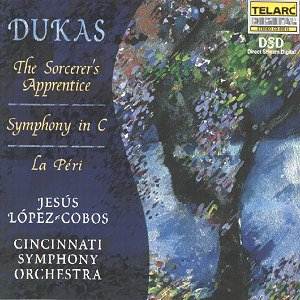Paul DUKAS (1865-1935)
Fanfare to La Péri,
La Péri
Symphony in C
The Sorcerer's Apprentice.
 Jesús López-Cobos
conducts the Cincinnati Symphony Orchestra
Jesús López-Cobos
conducts the Cincinnati Symphony Orchestra
 TELARC CD-80515 [72:02]
TELARC CD-80515 [72:02]

This CD is proof, as if there was ever need of any, that there is much more
to Paul Dukas' music than The Sorcerer's Apprentice. It is just a
pity that practically every album that is released of this composer's work
must include, by default, this over-exposed piece. I will, therefore, quickly
sweep it out of the way, after just saying that it receives an energetic
and perhaps slightly over-emphatic performance, and move on to the more
interesting items.
Dukas was born in Paris and began to compose at the age of thirteen. He entered
the Conservatoire, and became friends with d'Indy and Debussy and took as
idols, Beethoven and Wagner. He was much influenced by Shakespeare and the
classical authors. His music blends Classicism with Romanticism and
Impressionism.
Dukas' Symphony in C was first performed in Paris in 1897. The first movement
is swift moving but begins in Franckian austerity with a feeling of striving
after light from darkness. The major theme of the movement is indeed, very
reminiscent of Cesar Franck. As the music asserts itself, a more muscular
Beethovian influence is felt. Much of the music of this first movement is
therefore correspondingly strong and confident sometimes martial and heroic
- even a little chivalric. The Romantic Andante is the highlight of the Symphony.
It begins quietly with an almost prayer-like theme before soft agitated strings,
woodwinds and echoing horns transport us to some sensual Arcadian world that
blends impressionistic styles with those of the Russian romantics - especially
Borodin and Galzunov. The energetic finale recalls material from the first
movement and in parts echoes the Romanticism of the Andante. The feeling
of medieval chivalry is heightened.
The brief two-minute heraldic Fanfare to La Péri ushers in the work
proper. La Péri was premiered in Paris, in 1912. According to Persian
mythology, the péris are fairies and elves who are descended from
fallen angels. They cannot regain paradise until penance has been done. Dukas'
tale concerns a youth, Iskender, who has been roving the world looking for
the lotus, the flower of immortality. At last, he finds it in the possession
of a lovely péri. She is asleep. He steals it but cannot tear himself
away from her for he has fallen in love. She awakens and dances to play upon
his desire. Iskender, bewitched, returns the flower and both it and the
péri melt into the golden light of sunset, leaving Iskender alone
and desolate and recognising that he is doomed. Dukas fashions a vibrant,
colourful, monumental impressionistic score that captures the gossamer lightness
of the fairies and their quick dartings, the sultry atmosphere of the
péri's bower, and Iskender's amorous longings. The voluptuous dance
of the péri that is a whirling crescendo demanding virtuoso playing
especially from the strings that have incredibly fast precision work in their
highest register.
Recommended
Reviewer
Ian Lace


![]()